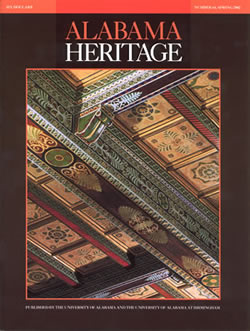|
On the cover: Architect Frank Lockwood's signature coffered ceiling in the courtroom of the Montgomery Federal Building. (Robin McDonald)
|
FEATURE ABSTRACTS
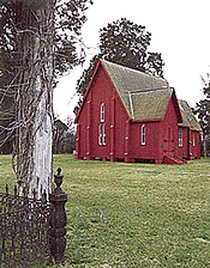 St. Andrew's Church in Prairieville
St. Andrew's Church in Prairieville(Robin McDonald)
Richard Upjohn in Alabama
By Robert Mellown and Robert Gamble
He designed some of nineteenth-century America's most famous buildings. His Italianate villa-style homes are worth millions today. But few people know that Richard Upjohn was perhaps best known in the American South for a much simpler set of blueprints that he practically gave away for free. An immigrant to the United States from England, Upjohn was commissioned to design New York's Trinity Church in 1833, a project which could have earned him a place in history by itself. But Upjohn was a devout Anglican with a sense of charity, and he wanted to design smaller, low-cost churches or struggling congregations who could not afford his professional services. The result was a slim volume published in 1852 entitled, Upjohn's Rural Architecture. In the Spring 2002 issue of Alabama Heritage, Robert Mellown and Robert Gamble examine the influence of Upjohn's "little book" on small Episcopal congregations in Alabama, who took Upjohn's plans for simple rural structures and created remarkably beautiful houses of worship. Some of these churches still stand today and have remained in use for a hundred and fifty years.
Additional Information
About the Authors
Robert Mellown, a professor of art history at the University of Alabama and an authority on Alabama art and architecture, is a frequent contributor to Alabama Heritage. He is also the edi tor of the magazine's Art in the South column.
Robert Gamble, Senior Architectural Historian for the Alabama Historical Commision, has written for Alabama Heritage
for many years and serves as a consultant for the AH staff.
By Robert Mellown and Robert Gamble
He designed some of nineteenth-century America's most famous buildings. His Italianate villa-style homes are worth millions today. But few people know that Richard Upjohn was perhaps best known in the American South for a much simpler set of blueprints that he practically gave away for free. An immigrant to the United States from England, Upjohn was commissioned to design New York's Trinity Church in 1833, a project which could have earned him a place in history by itself. But Upjohn was a devout Anglican with a sense of charity, and he wanted to design smaller, low-cost churches or struggling congregations who could not afford his professional services. The result was a slim volume published in 1852 entitled, Upjohn's Rural Architecture. In the Spring 2002 issue of Alabama Heritage, Robert Mellown and Robert Gamble examine the influence of Upjohn's "little book" on small Episcopal congregations in Alabama, who took Upjohn's plans for simple rural structures and created remarkably beautiful houses of worship. Some of these churches still stand today and have remained in use for a hundred and fifty years.
Additional Information
- Gamble Robert. Alabama Catalog: Historic American Buildings Survey: A Guide to the Early Architecture of the State (University of Alabama Press, 1987).
- Upjohn, Everard Miller. Richard Upjohn, Architect and Churchman (Columbia University Press, 1939).
About the Authors
Robert Mellown, a professor of art history at the University of Alabama and an authority on Alabama art and architecture, is a frequent contributor to Alabama Heritage. He is also the edi tor of the magazine's Art in the South column.
Robert Gamble, Senior Architectural Historian for the Alabama Historical Commision, has written for Alabama Heritage
for many years and serves as a consultant for the AH staff.
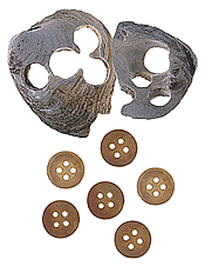 Before the mid-twentieth century,
Before the mid-twentieth century,buttons were often fashioned
from mussels
(Ricky Yanaura)
The Mussels of Muscle Shoals
By Stuart W. McGregor
Have you ever wondered how the Muscle Shoals region of North Alabama got its name? Here's a hint: you can eat the answer on the half-shell. Alabama's waterways have long been known for their phenomenal abundance of slimy, bivalve brachiopods-otherwise nown as mussels. But the construction of dams and canals on the Tennessee River in the early twentieth century has changed the environment and gradually diminished the number of mussels left. Is the decline of Alabama's mussel population something you should be concerned about? The answer may surprise you. In the Spring 2002 issue of Alabama Heritage, Stuart W. McGregor pries open the story of the mussels of Muscle Shoals and explains their importance to the wealth and welfare of the state. From the earliest human settlers in the region who relied on mussels for food, to the modern-day industrialists who cultivate pearls, McGregor traces the slippery course of mollusk events in North Alabama-and he explains why Muscle Shoals should have been Mussel Shoals.
Additional Information
Multimedia:
Stuart W. McGregor was born in Huntsville and reared in Florence from the age of two. He obtained a Bachelor of Arts degree with a double major in History and Environmental Biology from the University of North Alabama, and went on to receive a master's degree in Biology from Tennessee Tech University. After stints at the U.S. Fish and Wildlife Service and the Navigation Planning Division of the U. S. Army Corps of Engineers, he returned to Alabama in 1988 to work for the Environmental Geology Division of the Geological Survey of Alabama in Tuscaloosa. A past president of the Alabama Fisheries Association, McGregor's professional activities focus on documenting the current status and recent changes in the freshwater mussel fauna of Alabama and efforts to improve habitats to a level suitable for mussel life.
By Stuart W. McGregor
Have you ever wondered how the Muscle Shoals region of North Alabama got its name? Here's a hint: you can eat the answer on the half-shell. Alabama's waterways have long been known for their phenomenal abundance of slimy, bivalve brachiopods-otherwise nown as mussels. But the construction of dams and canals on the Tennessee River in the early twentieth century has changed the environment and gradually diminished the number of mussels left. Is the decline of Alabama's mussel population something you should be concerned about? The answer may surprise you. In the Spring 2002 issue of Alabama Heritage, Stuart W. McGregor pries open the story of the mussels of Muscle Shoals and explains their importance to the wealth and welfare of the state. From the earliest human settlers in the region who relied on mussels for food, to the modern-day industrialists who cultivate pearls, McGregor traces the slippery course of mollusk events in North Alabama-and he explains why Muscle Shoals should have been Mussel Shoals.
Additional Information
- Isom, B. G. "A biologist's look at the history of Muscle Shoals (Mussel Shoals)." Malacological Review, 1971, vol. 4, pp. 203-206.
- Owen, T. M. Muscle Shoals: History of Alabama and Dictionary of Alabama Biography, vol. II (S. J. Clarke Publishing Company, 1921).
- Win, Joshua Nicholas III. Muscle Shoals Canal: Life with the Canalers (Strode Publishers, Inc., 1981).
Multimedia:
- Painted Rock River Mussels
- Pink Mucket
- Sheepnose Mussel
- Shinyrayed Pocketbook
- Tennessee Heelsplitter
- Wabash Pigtoe
Stuart W. McGregor was born in Huntsville and reared in Florence from the age of two. He obtained a Bachelor of Arts degree with a double major in History and Environmental Biology from the University of North Alabama, and went on to receive a master's degree in Biology from Tennessee Tech University. After stints at the U.S. Fish and Wildlife Service and the Navigation Planning Division of the U. S. Army Corps of Engineers, he returned to Alabama in 1988 to work for the Environmental Geology Division of the Geological Survey of Alabama in Tuscaloosa. A past president of the Alabama Fisheries Association, McGregor's professional activities focus on documenting the current status and recent changes in the freshwater mussel fauna of Alabama and efforts to improve habitats to a level suitable for mussel life.
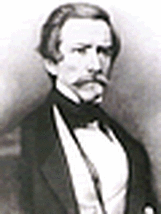 Admiral Raphael Semmes,
Admiral Raphael Semmes,captain of the C.S.S. Alabama
(University of South Alabama
Archives)
Mobile's Old Catholic Cemetery
By John S. Sledge
It was a place where the dead were laid to rest, and where the living drowned their sorrows in "spirituous liquors" on sale at the gravesite. Where else could you could find the poet who penned "The Sword of Robert E. Lee," the commanding admiral of the famed Confederate raider Alabama, the last slave runner in America, and the slaves he ran, all in the same place? Mobile has its share of historic graveyards, but none are quite as impressive as Old Catholic Cemetery. Not even New Orleans contains a funerary ground like this. In the Spring 2002 issue of Alabama Heritage, John S. Sledge leads a guided tour through one of the most mysterious cemeteries in the South. Beginning with Old Catholic's unusual circular design, Sledge walks us through the history of this sacred ground, stopping to admire the remarkable marble statuary along the way. Sledge also explains how Old Catholic Cemetery attests to the staying power of the Catholic Church in Mobile, despite dynamic changes in the city's culture throughout the nineteenth century. For anyone interested in the trials and rewards of historical preservation, the story of Old Catholic will come as a sobering reminder of what we stand to lose by letting the past stay buried.
Additional Information
About the Author
John S. Sledge is an architectural historian with the Mobile Historic Development Commission and book editor for the Mobile Register. He holds a master's degree in historic preservation from Middle Tennessee State University. Though raised in central Alabama, Sledge has deep roots on the Gulf Coast. His father grew up in Mobile's Georgia Cottage, formerly the home of Augusta Evans Wilson, and his mother lived in the Pontalba Building in New Orleans. He has written and lectured widely on Mobile's history and architecture.
By John S. Sledge
It was a place where the dead were laid to rest, and where the living drowned their sorrows in "spirituous liquors" on sale at the gravesite. Where else could you could find the poet who penned "The Sword of Robert E. Lee," the commanding admiral of the famed Confederate raider Alabama, the last slave runner in America, and the slaves he ran, all in the same place? Mobile has its share of historic graveyards, but none are quite as impressive as Old Catholic Cemetery. Not even New Orleans contains a funerary ground like this. In the Spring 2002 issue of Alabama Heritage, John S. Sledge leads a guided tour through one of the most mysterious cemeteries in the South. Beginning with Old Catholic's unusual circular design, Sledge walks us through the history of this sacred ground, stopping to admire the remarkable marble statuary along the way. Sledge also explains how Old Catholic Cemetery attests to the staying power of the Catholic Church in Mobile, despite dynamic changes in the city's culture throughout the nineteenth century. For anyone interested in the trials and rewards of historical preservation, the story of Old Catholic will come as a sobering reminder of what we stand to lose by letting the past stay buried.
Additional Information
- Christovich, Mary Louise. New Orleans Architecture: The Cemeteries. (Pelican, 1974).
- Connick, Lucille Mallon, ed. Tombstone Inscriptions: Catholic Cemetery, Mobile, Alabama. (Mobile Genealogical Society,1986).
- Jackson, Kenneth T. and Camila Jose Vergara. Silent Cities: The Evolution of the American Cemetery (Princeton Architectural Press, 1989).
About the Author
John S. Sledge is an architectural historian with the Mobile Historic Development Commission and book editor for the Mobile Register. He holds a master's degree in historic preservation from Middle Tennessee State University. Though raised in central Alabama, Sledge has deep roots on the Gulf Coast. His father grew up in Mobile's Georgia Cottage, formerly the home of Augusta Evans Wilson, and his mother lived in the Pontalba Building in New Orleans. He has written and lectured widely on Mobile's history and architecture.
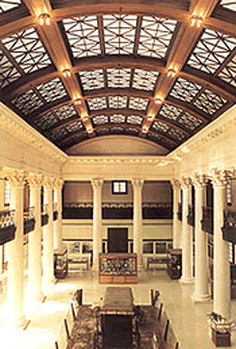 Smith Hall
Smith Hall(Robin McDonald)
Frank Lockwood and His Architectural Legacy
By John B. Scott Jr.
If you live in Alabama, you've probably seen his work, but chances are you don't know his name. He had the air of an Englishman, a certain charm with the ladies, and a voice so talented he drew the attention of the Metropolitan Opera. But Frank Lockwood is perhaps best remembered for designing some of the most impressive and important buildings in the state. The Montgomery Federal Building, a site of landmark civil rights court cases, is his legacy. So is the renovated State Capitol, as well as numerous other public and academic buildings throughout Alabama, not to mention dozens of churches and historic homes. John B. Scott Jr. traces the prolific career of one of Alabama's most notable architects. From Lockwood's sketchy educational background to his controversial work habits, Scott introduces the man whose life was no less remarkable than the buildings he left behind. For anyone interested in Alabama's rich architectural heritage, this is a must-read.
Additional Information
About the Author
Since retiring from active practice with the law firm of Capell & Howard, Montgomery native John Scott has been writing on Alabama's history and countryside. His articles on the Great Montgomery Monkey Trial (AH #61), Paint Rock Valley (AH #52), the Crommelin brothers of Montgomery (AH #46), and the old Clay County resort of Clairmont Springs (AH #42), have all graced the pages of this magazine. For their input and help with this article, Scott would like to thank Mary Ann Neeley and Taylor Dawson Jr., of Montgomery; Nicholas H. Holmes Jr., of Mobile; Vickie Hawkins of the
Talladega Public Library; and Walter Lockwood of Pace, Florida (a great grandson of Frank Lockwood). In addition, Bob Gamble provided architectural commentary for the article, as well as much helpful guidance on the biographical texts.
By John B. Scott Jr.
If you live in Alabama, you've probably seen his work, but chances are you don't know his name. He had the air of an Englishman, a certain charm with the ladies, and a voice so talented he drew the attention of the Metropolitan Opera. But Frank Lockwood is perhaps best remembered for designing some of the most impressive and important buildings in the state. The Montgomery Federal Building, a site of landmark civil rights court cases, is his legacy. So is the renovated State Capitol, as well as numerous other public and academic buildings throughout Alabama, not to mention dozens of churches and historic homes. John B. Scott Jr. traces the prolific career of one of Alabama's most notable architects. From Lockwood's sketchy educational background to his controversial work habits, Scott introduces the man whose life was no less remarkable than the buildings he left behind. For anyone interested in Alabama's rich architectural heritage, this is a must-read.
Additional Information
- Bowsher, Alice Meriwether. Alabama Architecture: Looking at Building and Place (University of Alabama Press, 2001).
- Gamble, Robert. Alabama Catalog: Historic American Buildings Survey: A Guide to the Early Architecture of the State (University of Alabama Press, 1987).
- Holmes, Nicholas H. Jr., "Charles Follen McKim and the Capital of Alabama," The Alabama Review, January 1989, pp. 3-31.
- Alabama Museum of Natural History
- Alabama State Capitol Building
- Frank M. Johnson Jr. Federal Building and Courthouse
About the Author
Since retiring from active practice with the law firm of Capell & Howard, Montgomery native John Scott has been writing on Alabama's history and countryside. His articles on the Great Montgomery Monkey Trial (AH #61), Paint Rock Valley (AH #52), the Crommelin brothers of Montgomery (AH #46), and the old Clay County resort of Clairmont Springs (AH #42), have all graced the pages of this magazine. For their input and help with this article, Scott would like to thank Mary Ann Neeley and Taylor Dawson Jr., of Montgomery; Nicholas H. Holmes Jr., of Mobile; Vickie Hawkins of the
Talladega Public Library; and Walter Lockwood of Pace, Florida (a great grandson of Frank Lockwood). In addition, Bob Gamble provided architectural commentary for the article, as well as much helpful guidance on the biographical texts.
DEPARTMENT ABSTRACTS
 Medusae
Medusae(W.Mike Howell)
The Nature Journal
Freshwater Jellyfish
By L. J. Davenport
Freshwater jellyfish have inhabited Alabama waters as long as (if not longer than) humans have inhabited its land. They exist as polyps far longer than they do in their medusal form, and the triggers this last stage remain a mystery. Because the appearance of the medusal form is so rare, its appearance in Alabama waters is an "event," and these unpredictably fluctuating opportunists have gained a certain mystique.
Additional Information
The following article in the Encyclopedia of Alabama will also be of interest:
About the Author
Larry Davenport is a professor of biology at Samford University, Birmingham, Alabama.
Freshwater Jellyfish
By L. J. Davenport
Freshwater jellyfish have inhabited Alabama waters as long as (if not longer than) humans have inhabited its land. They exist as polyps far longer than they do in their medusal form, and the triggers this last stage remain a mystery. Because the appearance of the medusal form is so rare, its appearance in Alabama waters is an "event," and these unpredictably fluctuating opportunists have gained a certain mystique.
Additional Information
The following article in the Encyclopedia of Alabama will also be of interest:
About the Author
Larry Davenport is a professor of biology at Samford University, Birmingham, Alabama.
Recollections
If the Legends Fade
Alabama Heritage Staff
Drivers passing Tom Hendrix's place, just off the Natchez Trace Parkway in Northwest Alabama, might not think twice about the stone wall that borders it, but for Hendrix the wall has a tremendous symbolic significance. He built it, with his own hands, in order to commemorate the forced removal--and eventual return--of his ancestors, members of the Yuchi tribe. The wall is part of Hendrix's quest to pass the story of is people along to anyone who wants to listen.
Additional Information
For more information or to order the book If the Legends Fade, visit Tom Hendrix's website.
If the Legends Fade
Alabama Heritage Staff
Drivers passing Tom Hendrix's place, just off the Natchez Trace Parkway in Northwest Alabama, might not think twice about the stone wall that borders it, but for Hendrix the wall has a tremendous symbolic significance. He built it, with his own hands, in order to commemorate the forced removal--and eventual return--of his ancestors, members of the Yuchi tribe. The wall is part of Hendrix's quest to pass the story of is people along to anyone who wants to listen.
Additional Information
For more information or to order the book If the Legends Fade, visit Tom Hendrix's website.
